Stabilisation of Nanosilver Supramolecular Hydrogels with Trisodium Citrate
Abstract
1. Introduction
2. Materials and Methods
2.1. Hydrogel Preparation
2.2. Differential Scanning Calorimetry (DSC)
2.3. Thermogravimetric Analysis (TGA/DTG)
2.4. NMR Spectroscopy
2.5. Microscopic Observation
3. Results
3.1. Calorimetric Tests (DSC)
3.2. Thermogravimetric Analysis (TGA + DTG)
3.3. 13C CPMAS NMR
3.4. Optical Images
4. Discussion
5. Conclusions
Author Contributions
Funding
Institutional Review Board Statement
Informed Consent Statement
Data Availability Statement
Conflicts of Interest
References
- Glushkov, D.; Paushkina, K.; Pleshko, A. Gel Fuels: Praparing, Rheology, Atomization, Combustion. Energies 2023, 16, 298. [Google Scholar] [CrossRef]
- Li, M.-G.; Wu, Y.; Cao, Q.-L.; Yuan, X.-Y.; Chen, X.; Han, J.-L.; Wu, W.-T. Rheological Properties of Organic Kerosene Gel Fuel. Gels 2022, 8, 507. [Google Scholar] [CrossRef] [PubMed]
- Nicoletti Telis, V.R. Biopolimer Engineering in Food Procesing; CRC Press: Boca Raton, FL, USA, 2012; ISBN 9781439844946. [Google Scholar]
- Zhi, L.; Liu, Z.; Wu, C.; Ma, X.; Hu, H.; Liu, H.; Adhikari, B.; Wang, Q.; Shi, A. Advances in preparation and application of food-grade emulsion gels. Food Chem. 2023, 424, 136399. [Google Scholar] [CrossRef]
- Aggarwal, G.; Nagpal, M. Pharmaceutical Polymer Gels in Drug Delivery. In Polymer Gels. Gels Horizons: From Science to Smart Materials; Thakur, V., Thakur, M., Voicu, S., Eds.; Springer: Singapore, 2018; pp. 249–284. [Google Scholar] [CrossRef]
- Siafaka, P.I.; Gündoğdu, E.A.; Cağlar, E.S.; Özgenç, E.; Gonzalez-Alvarez, M.; Gonzalez-Alvarez, I.; Okur, N.U. Polymer based Gels: Recent and Future Applications in Drug Delivery Field. Curr. Drug Deliv. 2023, 20, 1288–1313. [Google Scholar] [CrossRef]
- Sharmin, E.; Batubara, A.S.; Tamboosi, B.A.; Al Khozay, E.B.; Alamoudi, M.K.; Al Aidaroos, O.Z.; Albenayan, J.A.; Lamfom, M.Y.; Sindi, A.A.H.; Al-Madboly, L.A.; et al. PVA nanocomposite hydrogel loaded with silver nanoparticles enriched Nigella sativa oil. Inorg. Nano-Met. Chem. 2021, 52, 1134–1142. [Google Scholar] [CrossRef]
- Rammohan, A.; Kaduk, J.A. Trisodium citrate, Na3(C6H5O7). Acta Cryst. 2016, E72, 793–796. [Google Scholar] [CrossRef]
- Kubiński, K.; Górka, K.; Janeczko, M.; Martyna, A.; Kwaśnik, M.; Masłyk, M.; Zięba, E.; Kowalczuk, J.; Kuśtrowski, P.; Borkowski, M.; et al. Silver Is Not Equal to Silver: Synthesis and Evaluation of Silver Nanoparticles with Low Biological Activity, and Their Incorporation into C12Alanine-Based Hydrogel. Molecules 2023, 28, 1194. [Google Scholar] [CrossRef]
- Anjali Das, C.G.; Ganesh Kumar, V.; Stalin Dhas, T.; Karthick, V.; Govindaraju, K.; Mary Joselin, J.; Baalamurugan, J. Antibacterial activity of silver nanoparticles (biosynthesis): A short review on recent advances. Biocatal. Agric. Biotechnol. 2020, 27, 101593. [Google Scholar] [CrossRef]
- Liao, C.; Li, Y.; Tjong, S.C. Bactericidal and Cytotoxic Properties of Silver Nanoparticles. Int. J. Mol. Sci. 2019, 20, 449. [Google Scholar] [CrossRef]
- Ghiuță, I.; Cristea, D.; Croitoru, C.; Kost, J.; Wenkert, R.; Vyrides, I.; Anayiotos, A.; Munteanu, D. Characterization and antimicrobial activity of silver nanoparticles, biosynthesized using Bacillus species. Appl. Surf. Sci. 2018, 438, 66–73. [Google Scholar] [CrossRef]
- Agnihotri, S.; Mukherji, S.; Mukherji, S. Size-controlled silver nanoparticles synthesized over the range 5–100 nm using the same protocol and their antibacterial efficacy. RSC Adv. 2014, 4, 3974–3983. [Google Scholar] [CrossRef]
- Chen, L.Q.; Fang, L.; Ling, J.; Ding, C.Z.; Kang, B.; Huang, C.Z. Nanotoxicity of Silver Nanoparticles to Red Blood Cells: Size Dependent Adsorption, Uptake, and Hemolytic Activity. Chem. Res. Toxicol. 2015, 28, 501–509. [Google Scholar] [CrossRef] [PubMed]
- Choi, J.; Reipa, V.; Hitchins, V.M.; Goering, P.L.; Malinauskas, R.A. Physicochemical characterization and in vitro hemolysis evaluation of silver nanoparticles. Toxicol. Sci. 2011, 123, 133–143. [Google Scholar] [CrossRef]
- Riaz Ahmed, K.B.; Nagy, A.M.; Brown, R.P.; Zhang, Q.; Malghan, S.G.; Goering, P.L. Silver nanoparticles: Significance of physicochemical properties and assay interference on the interpretation of in vitro cytotoxicity studies. Toxicol. Vitr. 2017, 38, 179–192. [Google Scholar] [CrossRef]
- Lucky, S.S.; Chee Soo, K.; Zhang, Y. Nanoparticles in Photodynamic Therapy. Chem. Rev. 2015, 115, 1990–2042. [Google Scholar] [CrossRef]
- Kah, G.; Chandran, R.; Abrahamse, H. Biogenic Silver Nanoparticles for Targeted Cancer Therapy and Enhancing Photodynamic Therapy. Cells 2023, 12, 2012. [Google Scholar] [CrossRef] [PubMed]
- Available online: https://www.who.int/news/item/01-02-2024-global-cancer-burden-growing--amidst-mounting-need-for-services (accessed on 10 September 2024).
- Available online: https://www.who.int/news-room/fact-sheets/detail/antimicrobial-resistance (accessed on 10 September 2024).
- Liu, G.; Yang, L.; Chen, G.; Xu, F.; Yang, F.; Yu, H.; Li, L.; Dong, X.; Han, J.; Cao, C.; et al. A Review on Drug Delivery System for Tumor Therapy. Front. Pharmacol. 2021, 12, 735446. [Google Scholar] [CrossRef]
- Fornaguera, C.; García-Celma, M.J. Personalized Nanomedicine: A Revolution at the Nanoscale. J. Pers. Med. 2017, 7, 12. [Google Scholar] [CrossRef]
- Sastri, T.K.; Gupta, V.N.; Chakraborty, S.; Madhusudhan, S.; Kumar, H.; Chand, P.; Jain, V.; Veeranna, B.; Gowda, D.V. Novel Gels: An Emerging Approach for Delivering of Therapeutic Molecules and Recent Trends. Gels 2022, 8, 316. [Google Scholar] [CrossRef]
- Vigata, M.; Meinert, C.; Hutmacher, D.W.; Bock, N. Hydrogels as Drug Delivery Systems: A Review of Current Characterization and Evaluation Techniques. Pharmaceutics 2020, 12, 1188. [Google Scholar] [CrossRef]
- Dang, Y.; Guan, J. Nanoparticle-based drug delivery systems for cancer therapy. Smart Mater. Med. 2020, 1, 10–19. [Google Scholar] [CrossRef]
- Motulsky, A.; Lafleur, M.; Couffin-Hoarau, A.C.; Hoarau, D.; Boury, F.; Benoit, J.P.; Leroux, J.C. Characterization and biocompatibility of organogels based on L-alanine for parenteral drug delivery implants. Biomaterials 2005, 26, 6242–6253. [Google Scholar] [CrossRef]
- Bhattacharya, S.; Pal, A. Physical Gelation of Binary Mixtures of Hydrocarbons Mediated by n-Lauroyl-L-Alanine and Characterization of Their Thermal and Mechanical Properties. J. Phys. Chem. B 2008, 112, 4918–4927. [Google Scholar] [CrossRef] [PubMed]
- Pal, A.; Chhikara, B.S.; Govindaraj, A.; Bhattacharya, S.; Rao, C.N.R. Synthesis and properties of novel nanocomposites made of ingle-walled carbon nanotubes and low molecular mass organogels and their thermo-responsive behavior triggered by near IR radiation. J. Mater. Chem. 2008, 18, 2593–2600. [Google Scholar] [CrossRef]
- Okesola, B.O.; Smith, D.K. Applying low-molecular weight supramolecular gelators in an environmental setting—Self-assembled gels as smart materials for pollutant removal. Chem. Soc. Rev. 2016, 45, 4226–4251. [Google Scholar] [CrossRef] [PubMed]
- Miroslaw, B.; Demchuk, O.M.; Luboradzki, R.; Tyszczuk-Rotko, K. Low-Molecular-Weight Organogelators Based on N-dodecanoyl-L-amino Acids—Energy Frameworks and Supramolecular Synthons. Materials 2023, 16, 702. [Google Scholar] [CrossRef]
- Kowalczuk, J.; Łapiński, A.; Stolarczyk, E.; Demchuk, O.M.; Kubiński, K.; Janeczko, M.; Martyna, A.; Masłyk, M.; Turczyniak-Surdacka, S. New Supramolecular Drug Carriers: The Study of Organogel Conjugated Gold Nanoparticles. Molecules 2021, 26, 7462. [Google Scholar] [CrossRef]
- National Center for Biotechnology Information (2024). PubChem Compound Summary for CID 13854541, N-Lauroyl-L-Alanine. Available online: https://pubchem.ncbi.nlm.nih.gov/compound/N-Lauroyl-L-alanine (accessed on 22 October 2024).
- Antzutkin, O.N. Sideband manipulation in magic-angle-spinning nuclear magnetic resonance. Prog. Nucl. Mag. Reson. Spectrosc. 1999, 35, 203–266. [Google Scholar] [CrossRef]
- Brown, S.P. Probing proton-proton proximities in the solid state. Prog. Nucl. Mag. Reson. Spectrosc. 2007, 50, 199–251. [Google Scholar] [CrossRef]
- Ghosh, A.; Dey, J. Effect of Hydrogen Bonding on the Physicochemical Properties andBilayer Self-Assembly Formation of N-(2-Hydroxydodecyl)-L-alanine inAqueous Solution. Langmuir 2008, 24, 6018–6026. [Google Scholar] [CrossRef]
- Borkowski, M.; Orvalho, S.; Warszyński, P.; Demchuk, O.M.; Jarek, E.; Zawala, J. Experimental and theoretical study of adsorption of synthesized amino acid core derived surfactants at an air/water interface. Phys. Chem. Chem. Phys. 2022, 24, 3854–3864. [Google Scholar] [CrossRef] [PubMed]
- Sorrenti, A.; Illa, O.; Ortuño, R.M. Amphiphiles in aqueous solution: Well beyond a soap bubble. Chem. Soc. Rev. 2013, 42, 8200–8219. [Google Scholar] [CrossRef] [PubMed]
- Choucair, A.; Eisenberg, A. Control of amphiphilic block copolymer morphologies using solution conditions. Eur. Phys. J. E 2003, 10, 37–44. [Google Scholar] [CrossRef] [PubMed]
- Alexandridis, P.; Lindman, B. Amphiphilic Block Copolymers: Self-Assembly and Applications; Elsevier Science: Amsterdam, The Netherlands, 2000; ISBN 0-444-82441-3. [Google Scholar]
- Luo, C.; Yang, B.; Zhou, Y.; Yang, J.; Han, F.; Xu, B. Gelation properties and application based on amino acids gelators with four kinds of edible oils. Colloids Surf. A 2020, 585, 124184. [Google Scholar] [CrossRef]
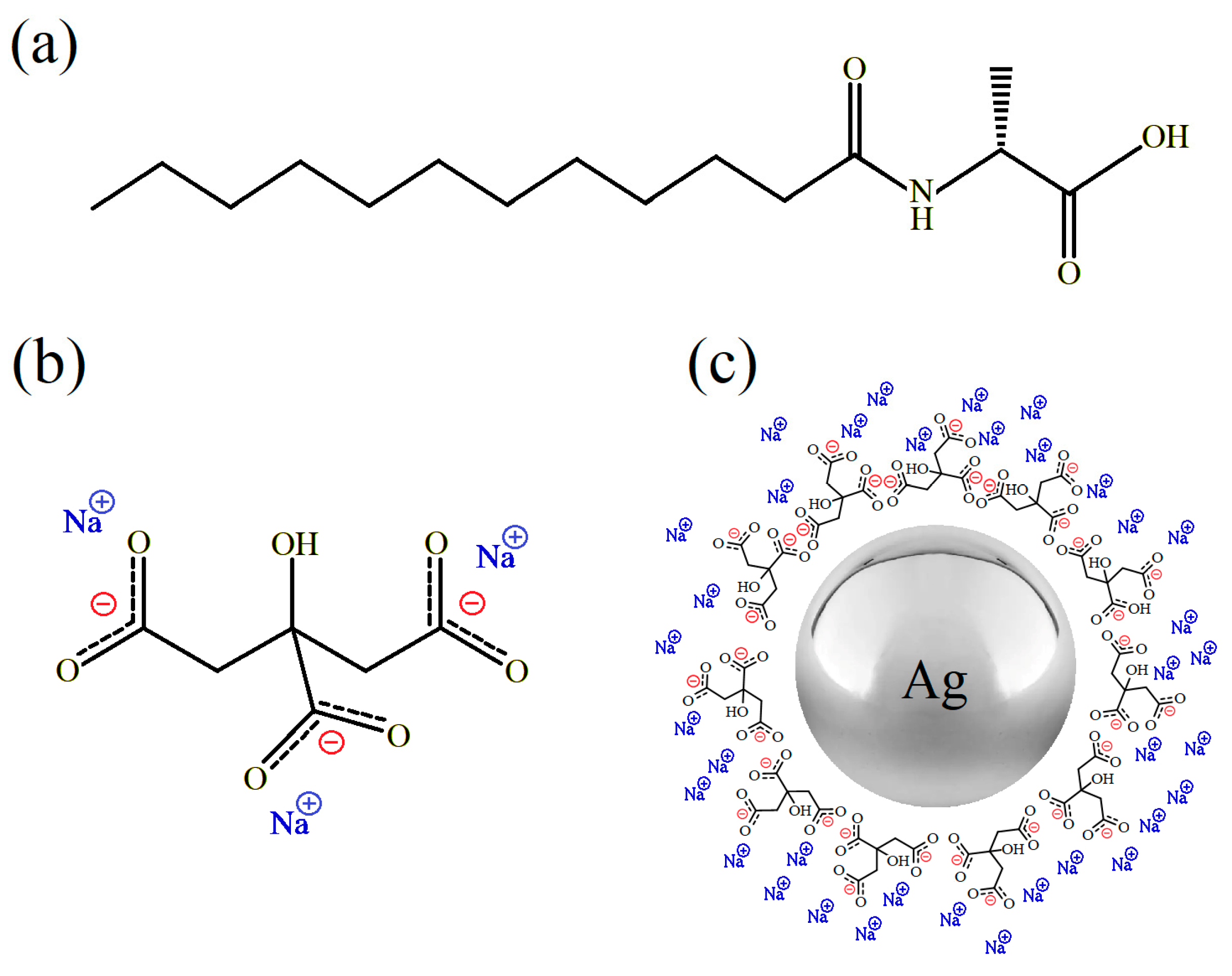
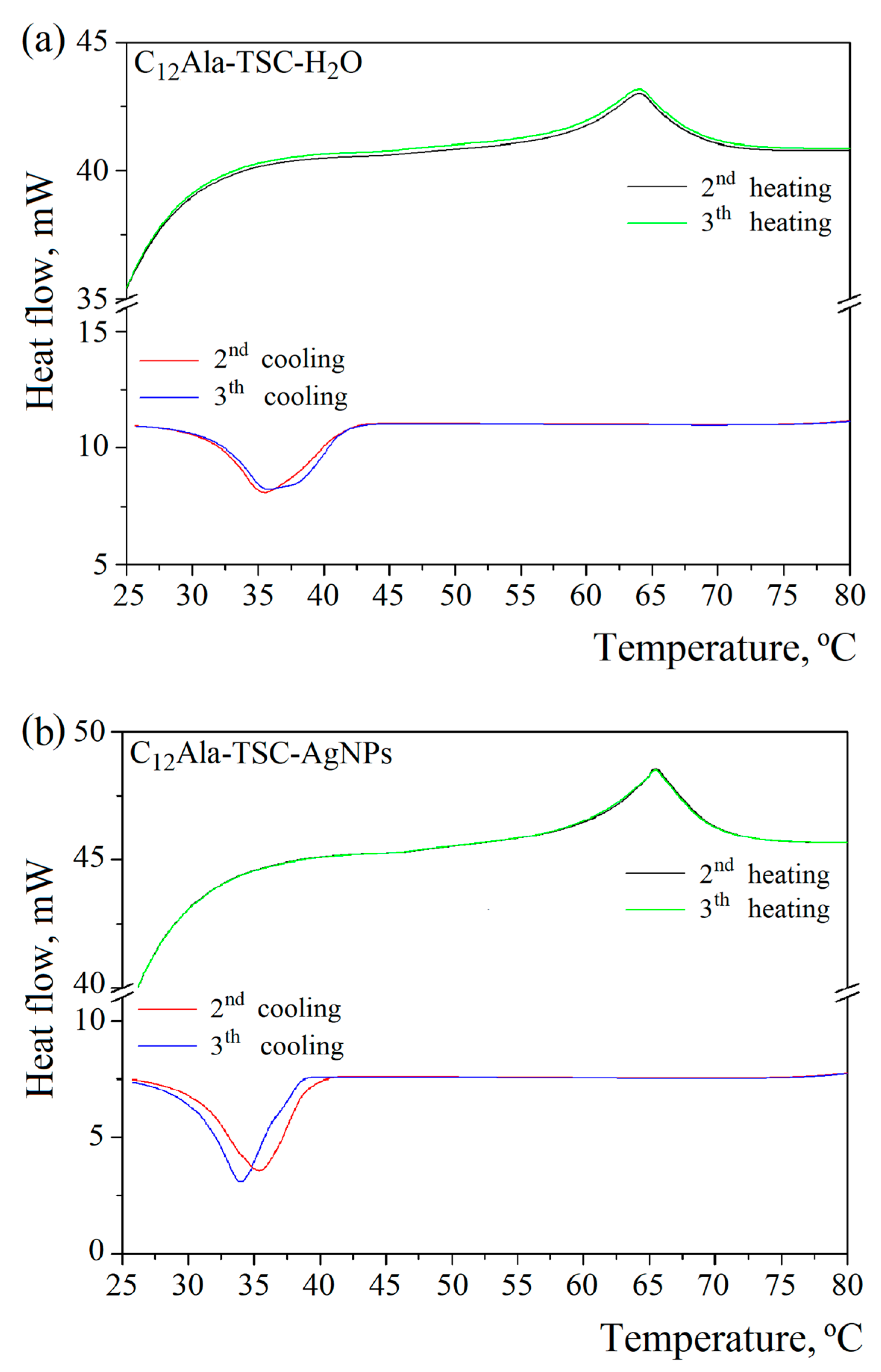
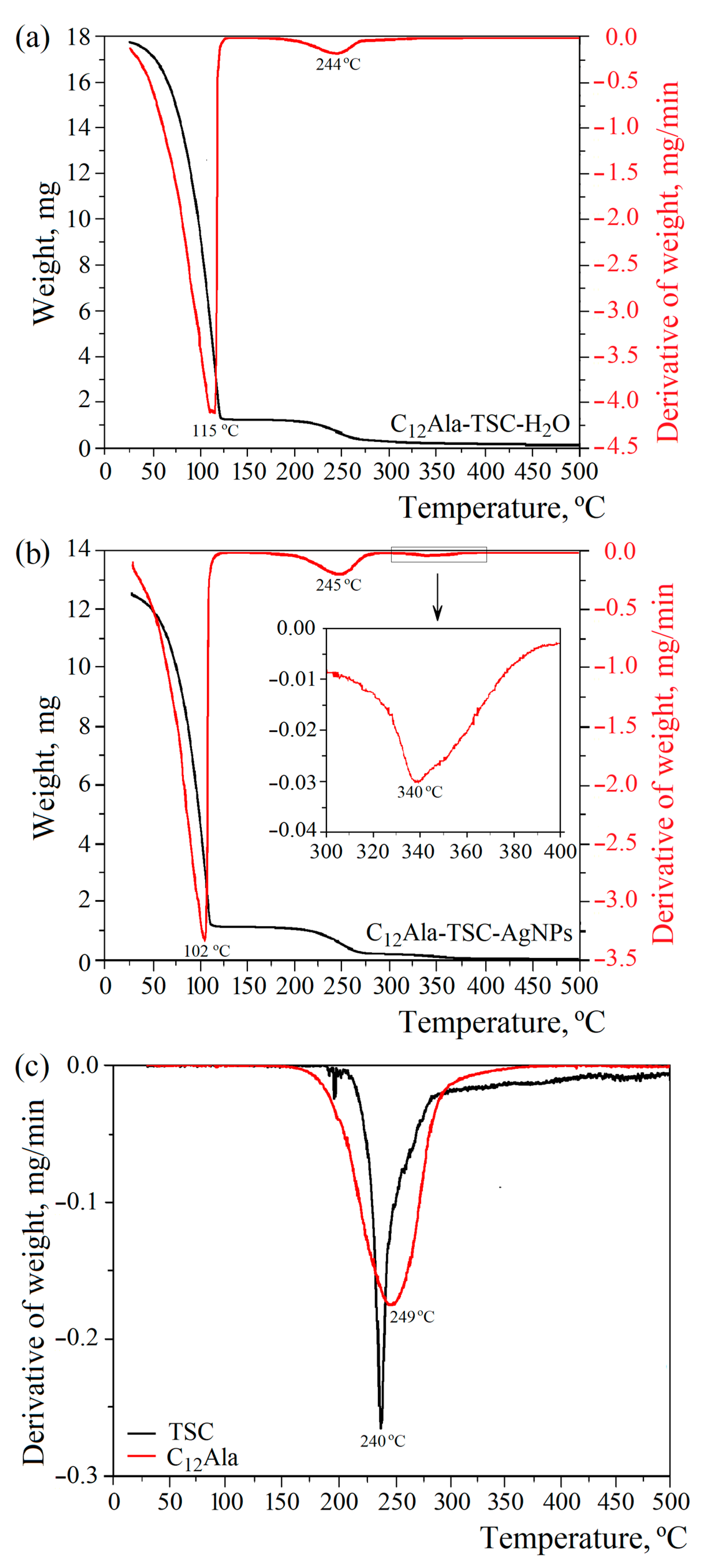
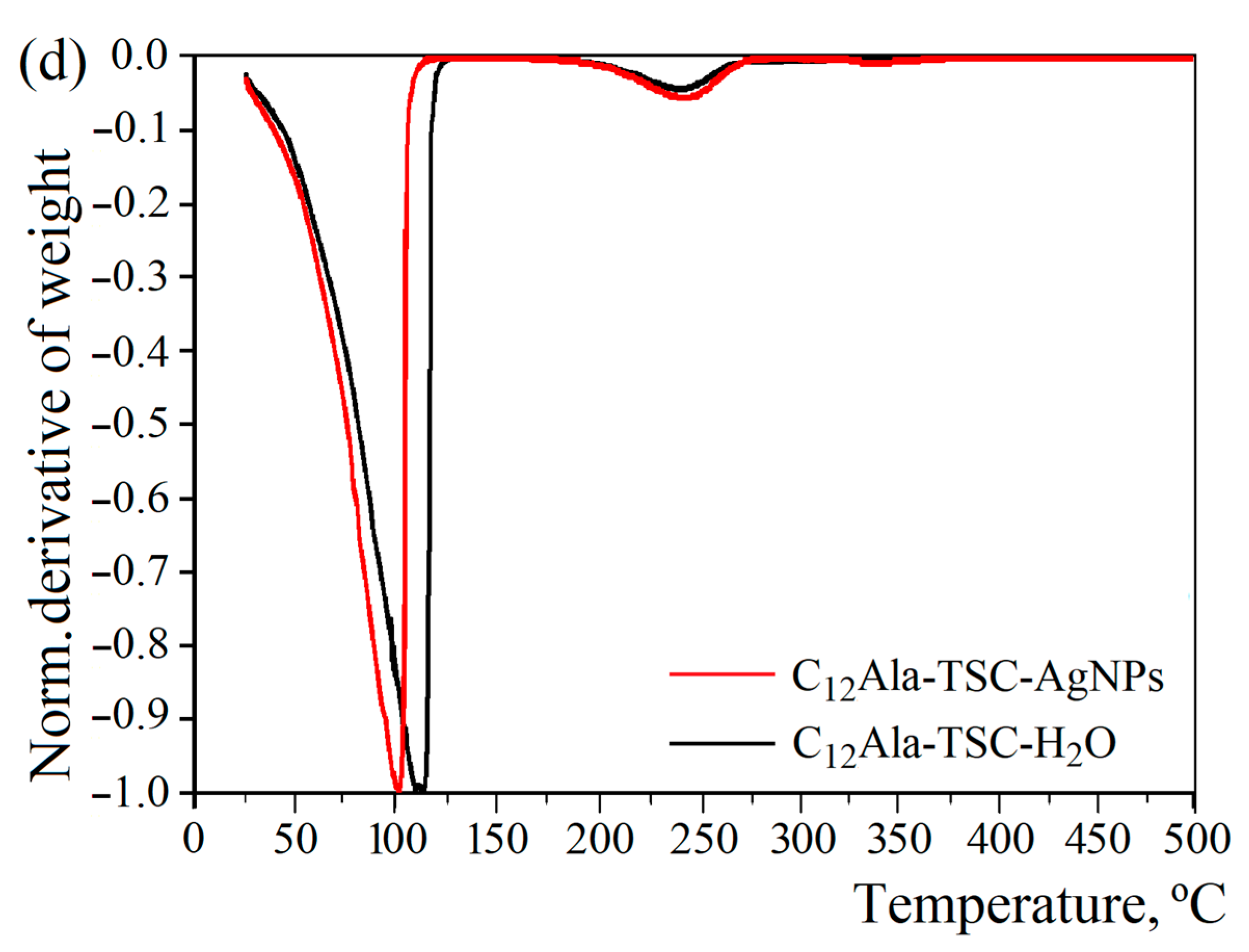
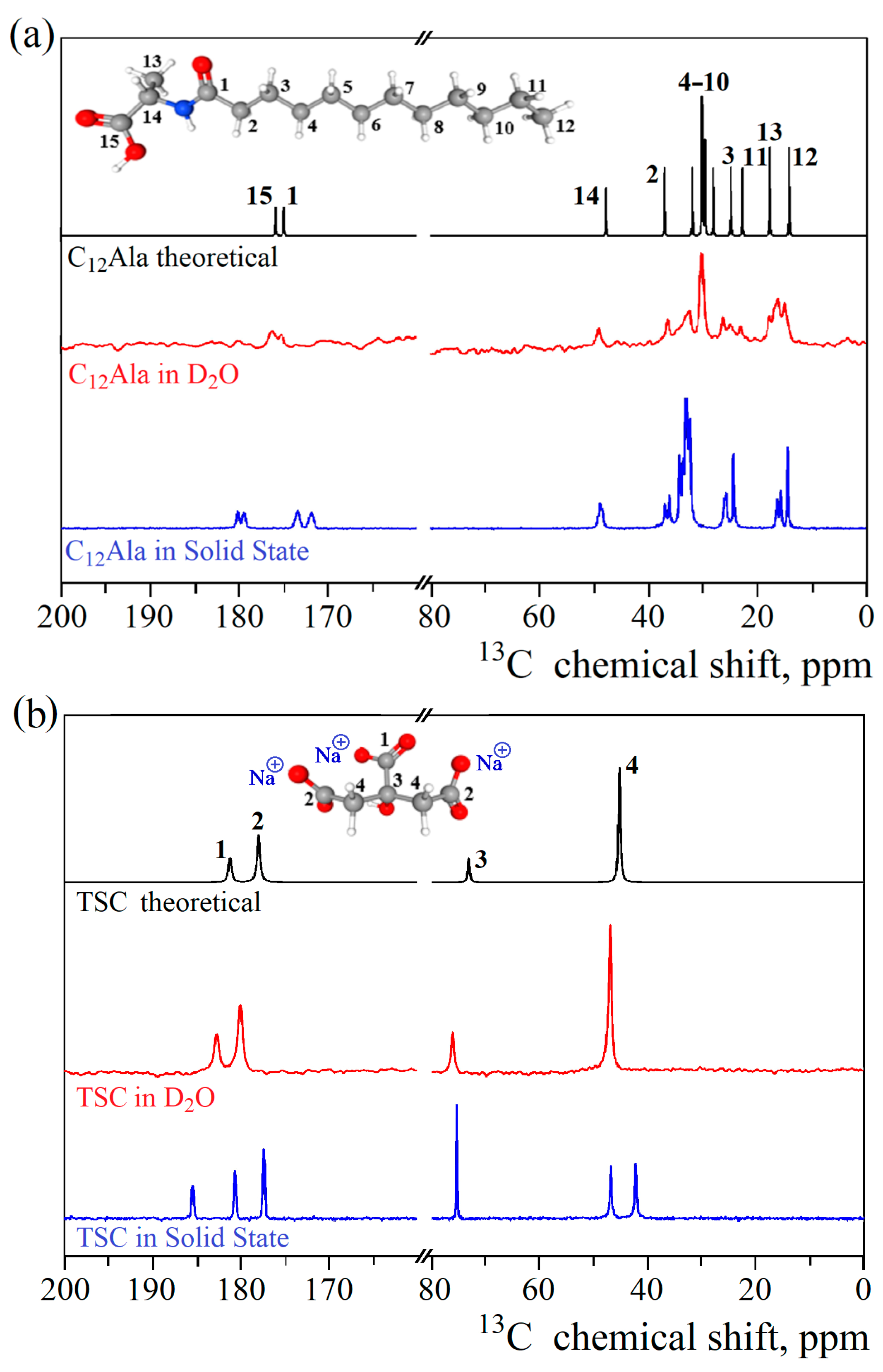
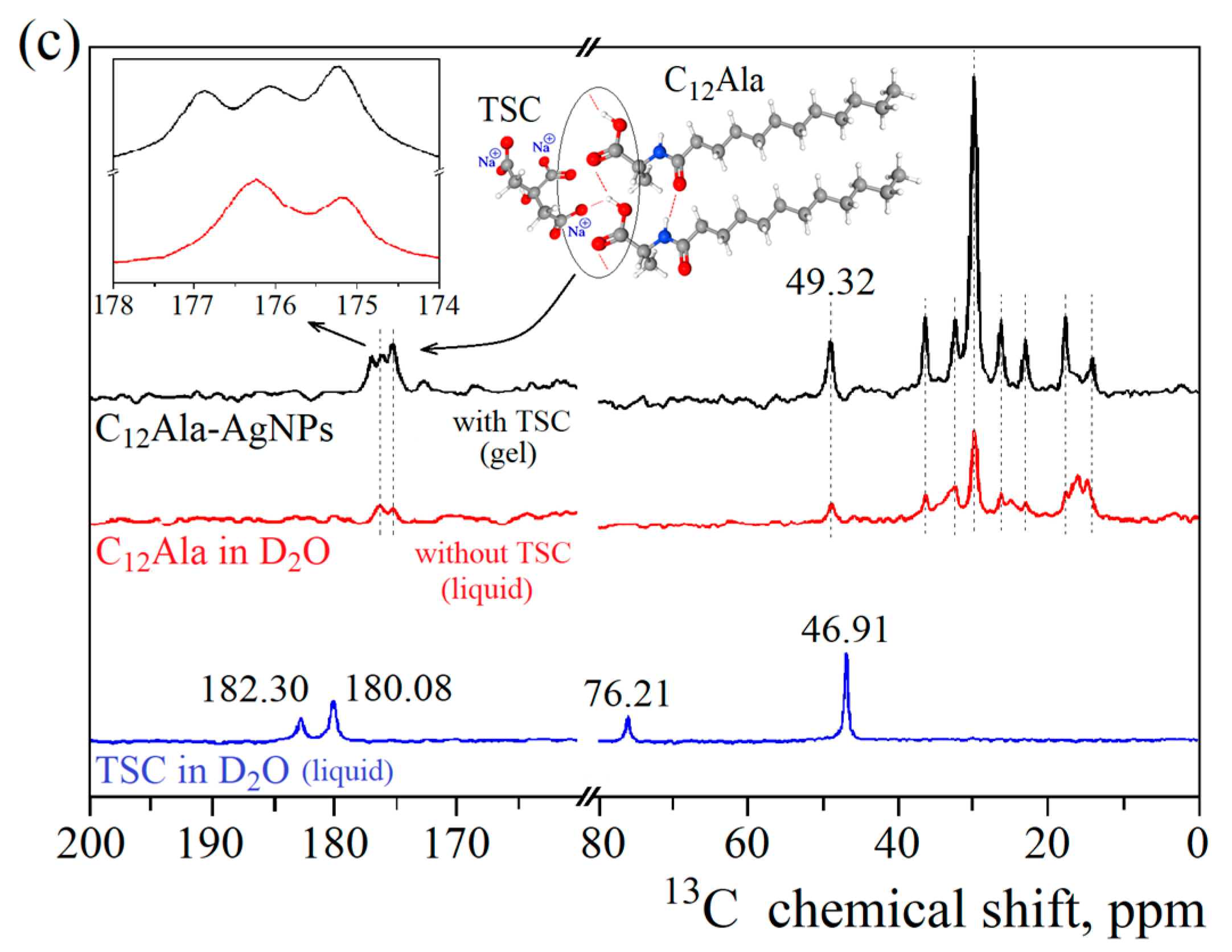

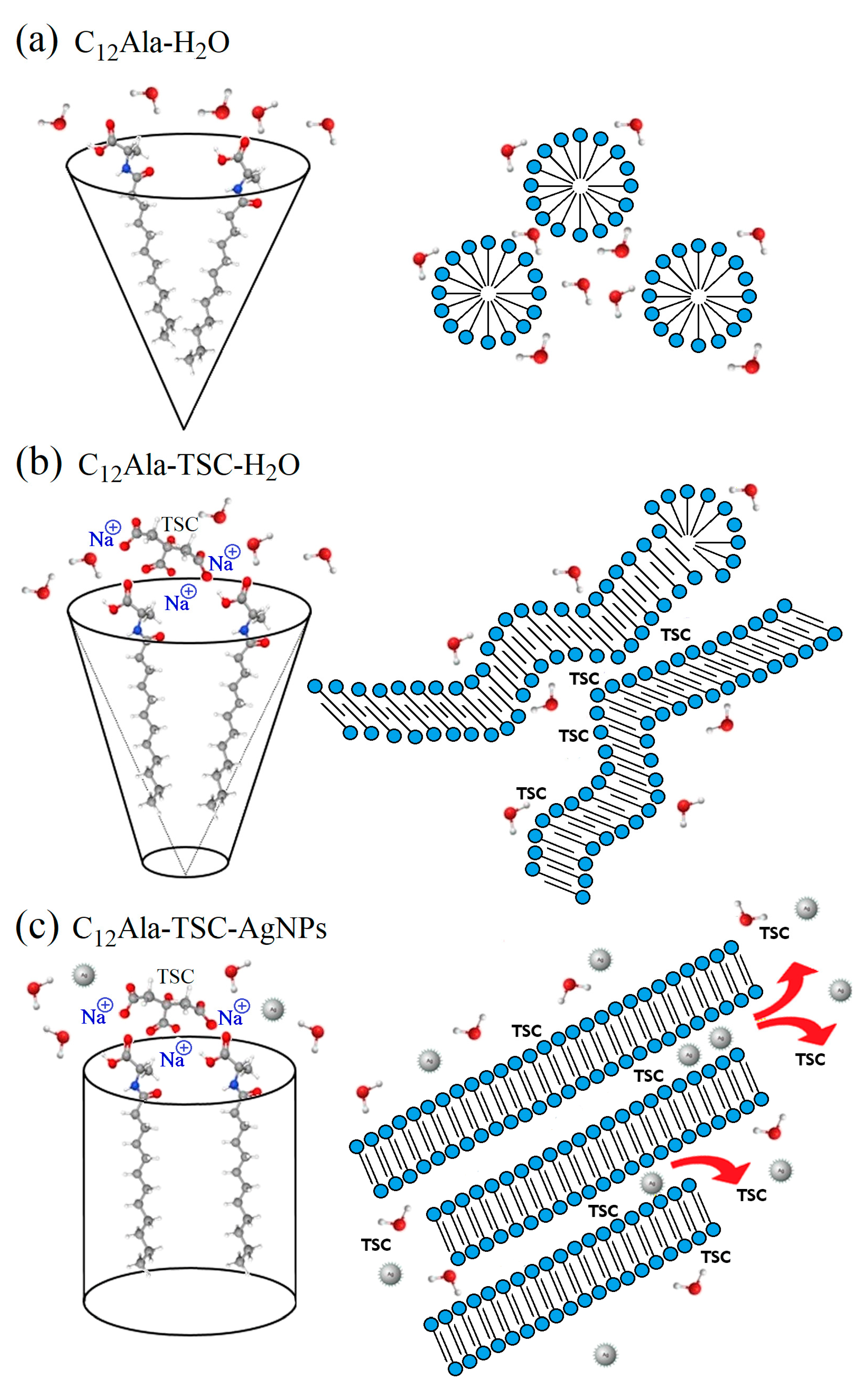
Disclaimer/Publisher’s Note: The statements, opinions and data contained in all publications are solely those of the individual author(s) and contributor(s) and not of MDPI and/or the editor(s). MDPI and/or the editor(s) disclaim responsibility for any injury to people or property resulting from any ideas, methods, instructions or products referred to in the content. |
© 2025 by the authors. Licensee MDPI, Basel, Switzerland. This article is an open access article distributed under the terms and conditions of the Creative Commons Attribution (CC BY) license (https://creativecommons.org/licenses/by/4.0/).
Share and Cite
Kowalczuk, J.; Demchuk, O.M.; Borkowski, M.; Bielejewski, M. Stabilisation of Nanosilver Supramolecular Hydrogels with Trisodium Citrate. Molecules 2025, 30, 1613. https://doi.org/10.3390/molecules30071613
Kowalczuk J, Demchuk OM, Borkowski M, Bielejewski M. Stabilisation of Nanosilver Supramolecular Hydrogels with Trisodium Citrate. Molecules. 2025; 30(7):1613. https://doi.org/10.3390/molecules30071613
Chicago/Turabian StyleKowalczuk, Joanna, Oleg M. Demchuk, Mariusz Borkowski, and Michał Bielejewski. 2025. "Stabilisation of Nanosilver Supramolecular Hydrogels with Trisodium Citrate" Molecules 30, no. 7: 1613. https://doi.org/10.3390/molecules30071613
APA StyleKowalczuk, J., Demchuk, O. M., Borkowski, M., & Bielejewski, M. (2025). Stabilisation of Nanosilver Supramolecular Hydrogels with Trisodium Citrate. Molecules, 30(7), 1613. https://doi.org/10.3390/molecules30071613







